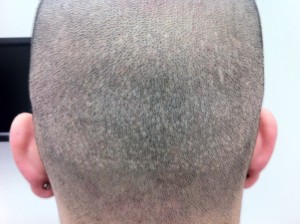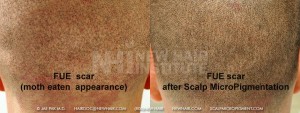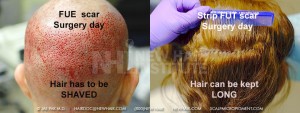This is an excerpt from the FDA website from 2010 on finasteride (https://www.accessdata.fda.gov/drugsatfda_docs/label/2011/020788s018lbl.pdf). Dr. Ed Epstein, from the Bosley Medical Group is a urologist by training and has kept up on the latest information on the impact or lack of impact of the drug finasteride on risks for an unborn fetus. “I am not aware of new studies on amounts of finasteride in semen or vaginal absorption data” that reflect increased risks for fetal abnormalities induced by finasteride other than what is written in the FDA white paper referenced above.
Some doctors are concerned that patients who go on finasteride should get semen analysis to keep track of semen levels in case these level dropped while a patient was on the drug finasteride. Dr. Epstein said: “Concerning getting semen analysis on child bearing age men starting finasteride, I totally disagree. Typically a male infertility workup is suggested after one year of unprotected intercourse. The subgroup of men who have low sperm counts on finasteride are those with preexisting conditions and appear to respond to discontinuation of finasteride.”In other words, he feels that a young man should not worry about either low semen counts caused by finasteride, but that they could always stop the drug and if there was a causal relationship, it would reverse. He also suggested than men with low sperm counts while on finasteride, probably had it before they started the drug and should get any low sperm count evaluated by an expert.
The FDA while paper referenced above showed that studies on semen in sperm were either not present or when present were so low as it not cause a risk to a pregnant woman or a woman who is expecting to become pregnant. “Semen levels have been measured in 35 men taking finasteride 1 mg/day for 6 weeks. In 60% (21 of 35) of the samples, finasteride levels were undetectable (<0.2 ng/mL). The mean finasteride level was 0.26 ng/mL and the highest level measured was 1.52 ng/mL. Using the highest semen level measured and assuming 100% absorption from a 5-mL ejaculate per day, human exposure through vaginal absorption would be up to 7.6 ng per day, which is 750 times lower than the exposure from the no-effect dose for developmental abnormalities in Rhesus monkeys and 650-fold less than the dose of finasteride (5 ?g) that had no effect on circulating DHT levels in men”Another opinion can be found here: https://www.medpagetoday.com/Endocrinology/Infertility/41424
I could’t help but think about what we do in our practice vs what Stossel talked about in this article. “the hospital’s customer service stinks. Doctors keep me waiting for hours, and no one bothers to call or email to say, “I’m running late.” Few doctors give out their email address. Patients can’t communicate using modern technology”.
At the New Hair Institute, every patient:
- Has the doctor’s cell phone number.
- Does not wait more than a few minutes before being seen.
- Service reviews are fantastic nearly 100% of the time.
- The service is personalized because we do not run a hair transplant ‘mill’ and care about our patients as human beings with a problem.
- Sterile condition and safety are top priority (not an infection in over a decade).
Scalp MicroPigmentation to fix FUE Scar
is now a well known method to hide old hair transplant linear scars. You can view many before and after photos on my website. Nowadays there is an uptick at my clinic in Los Angeles where I am seeing many unhappy patients with FUE scar. These unhappy patients are finding out FUE is NOT a scar-less or “no scar” surgery often advertised on the Internet and misrepresented by their doctors. Look at the FUE scar before photo and Scalp MicroPigmentation treated after photo. The before photo shows the result of a mottled, moth-eaten appearance, the consequence of a about 1000 graft FUE session. This condition which is now springing up all over the world as more clinics offer large FUE sessions ranging up 3000 or 5000 grafts a session. There are reports of skin necrosis and open wound infection. If you add up the total wound from a 3000 graft FUE surgery the collective open wound would be the size of a baseball. Imagine a bleeding open wound the size of a baseball on the back of your head. When you put it this way, FUE is not necessarily a minimally invasive surgery after all. While I’ve always been an advocate for large “Mega-Sessions” during the 1990s with strip surgery, you must think twice about FUE Mega-Sessions. These large FUE Mega-Session depletes the donor area and many men often complain about the see-through look on the back of their head. In an attempt to avoid a linear scar, these patients inherited another set of problems. In certain cases, the FUE scars can be treated with Scalp MicroPigmentation but the low density issue still remains. In my practice we try to limit the FUE session well below the 3000 graft range to avoid the moth eaten appearance of the resulting FUE scar.

FUE Scar
This is a photo of a female patient who had a hair line lowering and rounding hair transplant surgery. This is sometimes known as forehead reduction surgery.
*CLICK TO ENLARGE PHOTO
This patient did not like her square high forehead with receded corners. She thought her hair line looked too masculine. She considered a forehead reduction surgery to lower the hair line. However, she was worried about the hair line incision scar. She also wanted the hair line corners to be more rounded in appearance which a forehead reduction surgery could not achieve.
FOREHEAD REDUCTION Surgery:
Forehead reduction surgery for women with a high forehead has been popular since the late 1990s. Dr Sheldon Kabaker in Oakland California is a well known and prominent surgeon who has been offering female forehead reduction surgery for many years. It sometimes requires the use of tissue expanders to drastically lower one’s hair line. Since 2006 Dr. Gal Aharonov in Beverly Hills California has been offering a slightly modified approach to the forehead reduction surgery. His method has gained great popularity from all over the world. With third party review sites such as RealSelf.com, the hair transplant community saw a demand for women seeking an alternative to forehead reduction. Potential problems of a forehead reduction surgery were the visibility of a scar along the hair line, and the limitations of creating an oval or rounded appearance. While patients were happy with the drastic reduction in their forehead size, some were self conscious about their scar and would not wear their hair pulled back. They addressed this with make up and sometimes a limited hair transplant procedure.
HAIR TRANSPLANT for hair line lowering:
An alternative for those women who did not want to undergo a forehead reduction surgery was a standard hair transplant procedure. Hair transplant procedure involves harvesting donor hair from the back of the head to individually relocate single follicles to the front. The limitations of a hair transplant procedure was that the results were not instantaneous. The transplanted hairs need to grow out from its roots. The advantage was a natural shaped hair line dictated by the artistry of the doctor creating the hair line. There was no scarring along the hair line.
The results for this hair line lowering patient were achieved using Follicular Unit Strip Surgery (strip surgery) sometimes referred as Follicular Unit Transplant (FUT). If Follicular Unit Extraction (FUE) method was used, it would have required shaving the back of the patient’s head. This is something few women would accept. There is no shaving involved with the strip surgery and the incision around the donor area (back of head) is covered by the patient’s hair. Even with the hair wet or hair up, the incision line (scar) will rarely, if ever be noticed. This incision may be an issue for men who keep their hair very short.
If the incision is an issue for a patient, the alternative method of harvesting hair is known as Follicular Unit Extraction (FUE). FUE harvesting is carried out manually by a highly trained surgeon or with an aid of the ARTAS robotic FUE instrument. There are other machines available such as Dr. Harris’s SAFE system or the NeoGraft machine you may have seen advertised in airline magazines. FUE method of donor hair harvesting may seem attractive for many patients because it is heavily marketed and advertised as a “no scar” surgery. This is NOT an accurate statement and is shunned by doctors since FUE does leave thousands of permanent round scars. Many patients have their FUE scars as well as strip scars camouflaged with Scalp MicroPigmentation.
This reinforces the fact that the latest technology and fancy robots are not always the best choice. For most women, a small linear scar on the back of their head may be a better option than shaving their head for thousands of FUE “dot” scars. Think of a C-section scar under long hair vs a moth eaten appearance on the back of a shaved head.
It is common to have a patient visit me after seeing other doctors in the LA area. I like it when patients shop around because then they can judge the way the doctor practices his art. Many times the patients were told to get more grafts than they needed. For example, I might recommend 1500 grafts, other doctors might recommend 2500 grafts or 3000 grafts. Clearly the doctor makes more money the more grafts he places.
The real problem here is not only a financial one, it is a damage issue if the doctor transplants hair into a healthy recipient area just to unload the extra-grafts he took out. Now add to that every graft that is wasted, is lost from the donor supply for the rest of the life of the patient so such dishonest doctors are not just crooks, but they actually damage both your recipient area and your donor area, and at the same time take more money from you then he should.
Don’t get me wrong, Many times I will recommend 2000 or 3000 grafts in a bald person when THEY NEED IT. So, shop around and come see us if you are in Los Angeles or take advantage of our telephone consultation process where you can get a second opinion free of charge.
Did you know that 40% of our daily behavior is habitual freeing up our minds for other things. This was a cover story in the January 16th issue of New Scientists. Think, if you could only control your brain and put it into autopilot more often. The focus of the article is to tell us that we can train our brain. As I read the article I started to think how much time I spend driving in Los Angeles, and most is on autopilot. The answer to the question posed, it is both good and bad. Nail biting is a habit, is it bad? Brushing your teeth before bedtime or in the morning can be a habit as well as eating sweets at work. If you can retrain your brain towards against bad health habits, maybe you will live longer. The article warns that habit take a long time to make or break but there is no time like the present to start focusing on them.
We were explaining our hair transplant and Scalp Micropigmentation procedures to a group of patients today and we were shocked to find our pictures lifted off of our various websites and now appearing on the web sites of other doctors. This, of course, is a copyright infringement so letters are now being sent out by our lawyer informing these doctors that if they do not remove these photographs, then we will take legal action against them. They appeared on doctors websites and various other clinics from all over the world, not just the United States.

There was a case many years ago when I brought one of my patient to an international ISHRS medical meeting. This patient who was completely bald (Norwood 7) had phenomenal results in one session due to his unusual high donor hair density. Doctors were photographing him at the meeting. Later I found these photos on the doctor’s websites claiming that he was their patient! I guess that being a thief is really a matter of what is best for your pocketbook when it comes to unethical practices.
There seems to be a problem for many doctors wanting to get into Scalp MicroPigmentation but they do not have good before and after photos or reviews to show prospective patients. They take a short cut and plagiarize pictures they need off of the Internet. There seems to be no moral scruples among these thieves. Even a doctor can be a thief. We even found some of our photos with our own NHI WATERMARKS on them, telling those who see them that these photos originate from the New Hair Institute. We even found one of our celebrity patients on the site of another doctor.
What does this mean? It means that as a buyer, you must be careful for what the doctors are showing you, as what you are seeing may not be what you are getting.
When Dr. Rassman is not busy inventing hair transplant related devices and procedures, he runs a company called Mavenbiotech.
He will summarize the label-free imaging technology for measuring biomolecular interactions in a microarray format by using a video with ping pong balls to illustrate how antibodies work. Dr. Rassman believes that this technology will change the timeliness of medical care delivery
For those who cannot wait, skip to 4:50 on the video.
Transplantation of the bioengineered, 3D integumentary organ system using mouse iPS cells labeled with GFP© RIKEN, TAKASHI TSUJI
This is important because these stem cells were taken from the gums of mice and were able to grow a full thickness skin with hair follicles on it.
Scientist at Japan’s Riken Centre for Developmental Biology published their results on Science Advances.
Is this a view of the future?




